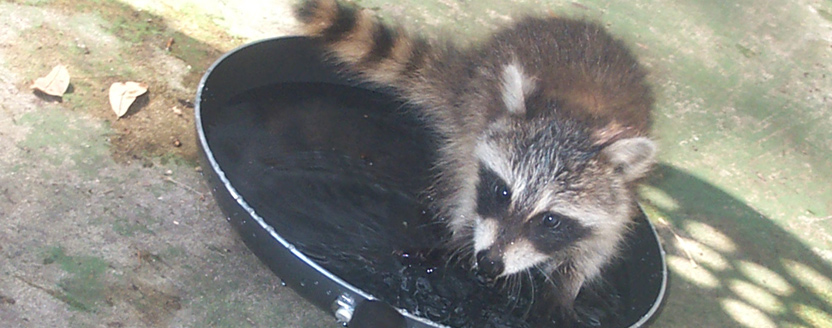NEED LOCAL HELP? We have wildlife removal professionals servicing 95% of the USA. Click here to hire a local raccoon removal expert in your home town. Updated 2018. But read the below advice first!
The raccoon we’re dealing with is no longer a wild animal. This mammal is actually the poster child for urban animals. Originally, before they started migrating and adapting perfectly to our rural and urban areas, raccoons liked living near riverbanks where their diets consisted mainly of frogs and crustaceans. With an extraordinary sense of touch, they would forage for food under muddy waters.

Actually, it is exactly this way of feeding that made them develop such an acute sense of touch in their front feet. So, when we see a raccoon in water, what strikes us as a familiar hand-washing movement is actually their instinct at work – they use water to soften thick nerve meshes in the calloused layer of the skin. They had to develop this behavior in the wild in order to be able to “see” the food with their hands so that they could keep their eyes wide open for predators.
This innate dexterity and very good sense of touch have perfectly prepared them for the challenges of finding food in any type of environment. They are omnivorous creatures, and that means they will eat anything we eat. So, you could say that the coon’s natural diet is the omnivorous diet. They depend on the food that’s available where they live, and have no problem whatsoever in changing diets when they’re relocated. Urban and suburban raccoons are still very much attracted to water – it’s probably encrypted in their DNA – but they can live without access to rivers their entire lives, thriving in highly populated cities and towns. And while in the recent past they kept to park and water areas feeding on the natural resources they found there, nowadays they’ve started to move more and more into our concrete areas, using their hand-like abilities to gorge on our leftovers and any other food sources we keep around our living space.
A raccoon will always find something to eat, and city raccoons are known to have several feeding places that they visit regularly. So, please, don’t feed raccoons. First of all, more and more raccoons will come for the nice handout, and you definitely don’t want that. Feeding raccoons poses a health risk for you and your pets, and can be a danger to the actual structure you live in if they decide to set shop in your attic or anywhere else on your property.
Go back to the Raccoons in the attic home page.